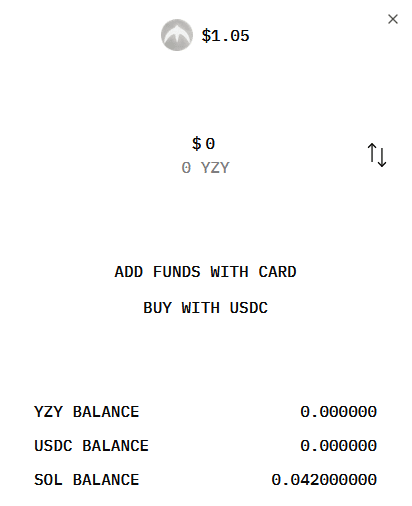Yeezy money is here. It’s real. Better known as “YZY Meme coin,” Kanye West, now known simply as Ye, launched his YZY token on Solana, sparking immediate frenzy.
Within just 40 minutes of release, the coin’s market cap ballooned to $3 billion, before tumbling back to $1.05 billion, according to Nansen data.
There’s only one other celebrity with that kind of MCAP for a cryptocurrency and it’s TRUMP. As big as Ye is, many are starting to believe there’s no room to make money here.
On X, Ye promoted the token as part of “Yeezy Money,” which he described as:
“A NEW ECONOMY, BUILT ON CHAIN,” Ye wrote.
“The official YZY token just dropped,” he later added.
And a new shilling campaign starts… so is YZY legit or a scam?
DISCOVER: 20+ Next Crypto to Explode in 2025
YZY Meme Coin: Allegations of Insider Trading
Despite the hype, on-chain analysts quickly raised red flags. Coinbase director Conor Grogan said that insiders held 94% of the supply, with one wallet initially controlling 87% before dispersal. Lookonchain reported that liquidity was structured in a way that gave developers outsized control over sales.
Conor Grogan: “At least 94% of the supply was insider-held.”

Some insiders made millions in profit. One trader spent $24,000 in Solana priority fees to secure $3.4 million gains, while another pocketed $6 million at peak. Others weren’t as lucky—one user lost $710,000 after buying the wrong contract before recovering on the correct one.
DISCOVER: Next 1000X Crypto: 10+ Crypto Tokens That Can Hit 1000x in 2025
Is This Giving Anyone End-of-Bullrun Vibes?
High-profile traders didn’t shy away. Leveraged trader James Wynn said he aped into YZY, comparing it to Trump’s $TRUMP memecoin:
“Aped $YZY on a 60% pull back. $TRUMP ran from $4bn to $15bn in 28 hours. 4x,” Wynn said.
BitMEX co-founder Arthur Hayes also appeared to join in, underscoring the appetite for celebrity tokens despite risks.
Only Down From Here. BTC Back to 105k
After Trump launched his meme coin in January, Bitcoin slid dramatically. Could we see something similar here?
YZY’s debut stormed into the top five fastest tokens to hit a $1B market cap this year, only to collapse just as quickly, echoing that traders are drunk on gambling right now. YZY could be the canary in the coal mine.
EXPLORE: Tether CEO Paolo Ardoino Hopes For Net Positive From US Elections, Says Bitcoin Strategic Reserve Is A Great Idea: 99Bitcoins Exclusive
Join The 99Bitcoins News Discord Here For The Latest Market Updates
Key Takeaways
- Yeezy money is here. It’s real. Better known as “YZY Meme coin,” Kanye West, now known simply as Ye, launched his YZY token on Solana.
- YZY’s debut stormed into the top five fastest tokens to hit a $1B market cap this year, only to collapse just as quickly
The post Kanye West’s YZY Meme Coin Rockets to $3B, But Insider Concerns Cast a Shadow appeared first on 99Bitcoins.
#Kanye #Wests #YZY #Meme #Coin #Rockets #Insider #Concerns #Cast #Shadow
#Kanye #Wests #YZY #Meme #Coin #Rockets #Insider #Concerns #Cast #Shadow